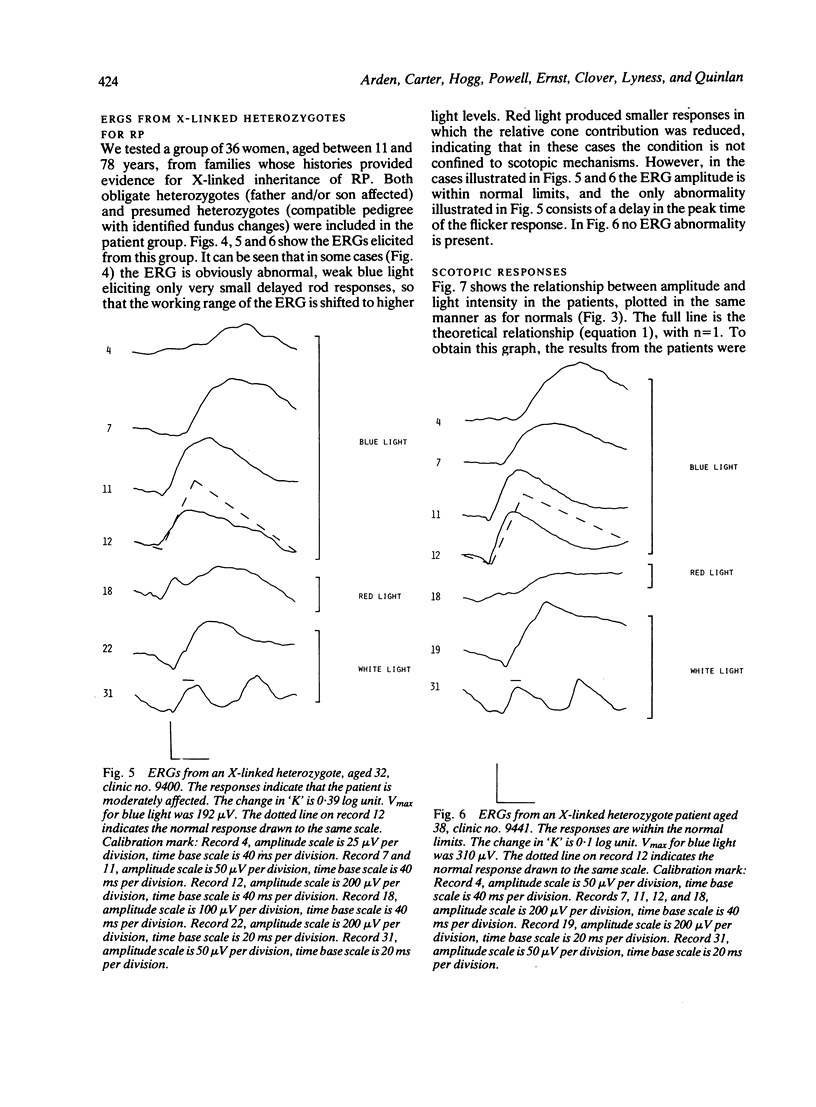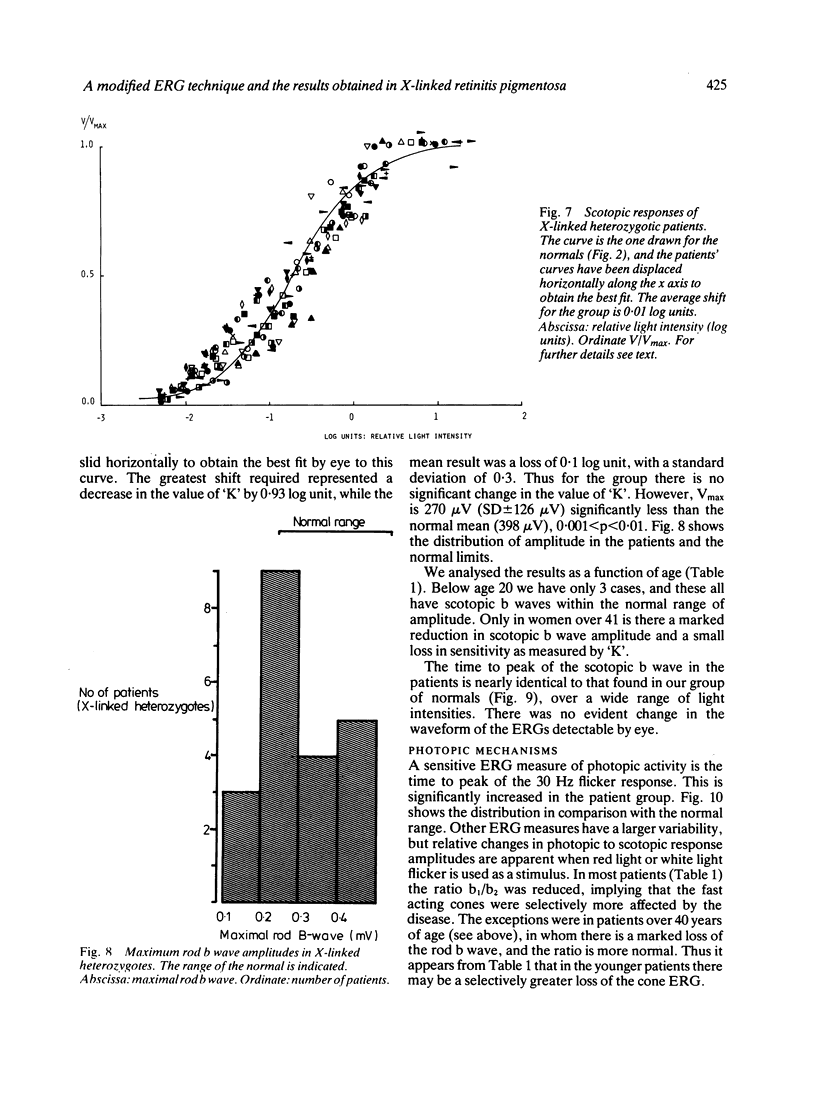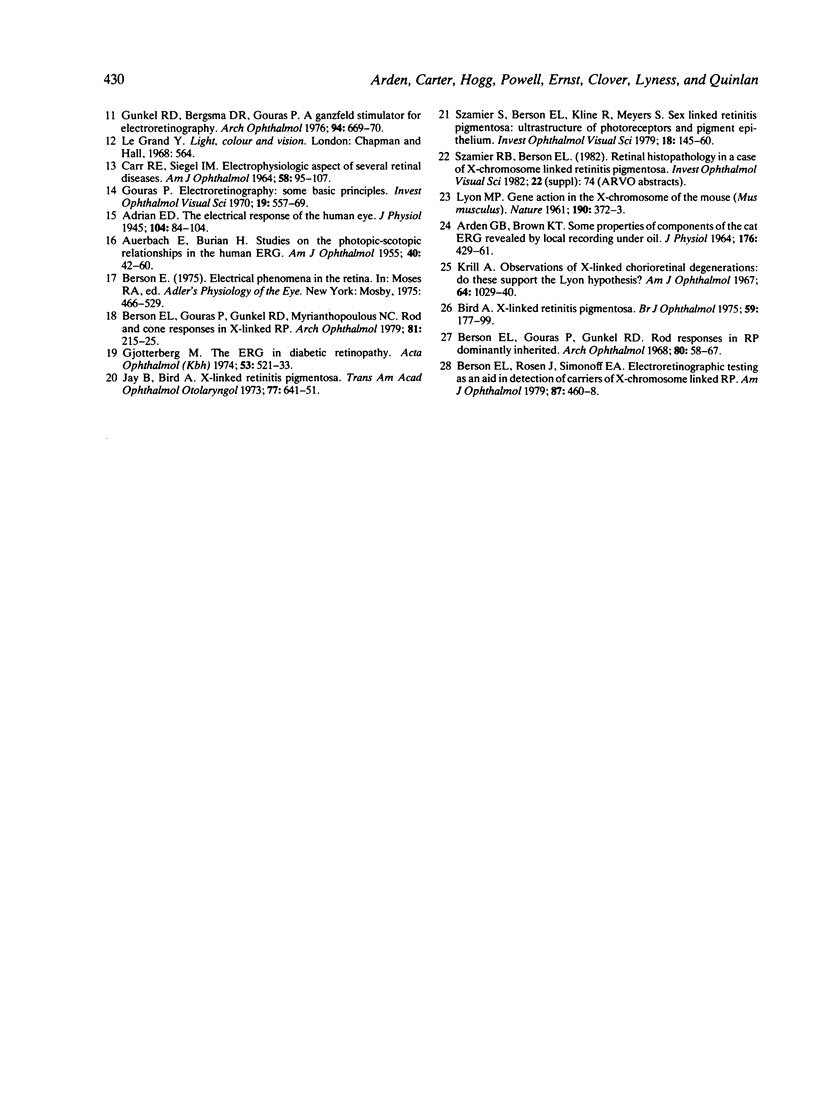Abstract
An electroretinographic (ERG) technique is described in which the relationship between scotopic b wave amplitude and stimulus light intensity is determined. The relative amplitude of scotopic to photopic responses is assessed by means of red light and flicker. The method is applied to the detection of ERG abnormalities in heterozygotes for X-linked retinitis pigmentosa. These have been found in only a proportion of cases. The ERG results can be used to suggest the nature of the retinal abnormality.
Full text
PDF











Selected References
These references are in PubMed. This may not be the complete list of references from this article.
- ARDEN G. B., BROWN K. T. SOME PROPERTIES OF COMPONENTS OF THE CAT ELECTRORETINOGRAM REVEALED BY LOCAL RECORDING UNDER OIL. J Physiol. 1965 Feb;176:429–461. doi: 10.1113/jphysiol.1965.sp007560. [DOI] [PMC free article] [PubMed] [Google Scholar]
- ARMINGTON J. C., JOHNSON E. P., RIGGS L. A. The scotopic A-wave in the electrical response of the human retina. J Physiol. 1952 Nov;118(3):289–298. doi: 10.1113/jphysiol.1952.sp004794. [DOI] [PMC free article] [PubMed] [Google Scholar]
- AUERBACH E., BURIAN H. M. Studies on the photopic-scotopic relationships in the human electroretinogram. Am J Ophthalmol. 1955 Nov;40(5 Pt 2):42–60. doi: 10.1016/0002-9394(55)91836-5. [DOI] [PubMed] [Google Scholar]
- Adrian E. D. The electric response of the human eye. J Physiol. 1945 Jun 29;104(1):84–104. doi: 10.1113/jphysiol.1945.sp004109. [DOI] [PMC free article] [PubMed] [Google Scholar]
- Arden G. B., Carter R. M., Hogg C., Siegel I. M., Margolis S. A gold foil electrode: extending the horizons for clinical electroretinography. Invest Ophthalmol Vis Sci. 1979 Apr;18(4):421–426. [PubMed] [Google Scholar]
- Baylor D. A., Hodgkin A. L., Lamb T. D. The electrical response of turtle cones to flashes and steps of light. J Physiol. 1974 Nov;242(3):685–727. doi: 10.1113/jphysiol.1974.sp010731. [DOI] [PMC free article] [PubMed] [Google Scholar]
- Berson E. L., Gouras P., Gunkel R. D., Myrianthopoulos N. C. Rod and cone responses in sex-linked retinitis pigmentosa. Arch Ophthalmol. 1969 Feb;81(2):215–225. doi: 10.1001/archopht.1969.00990010217012. [DOI] [PubMed] [Google Scholar]
- Berson E. L., Gouras P., Gunkel R. D. Rod responses in retinitis pigmentosa, dominantly inherited. Arch Ophthalmol. 1968 Jul;80(1):58–67. doi: 10.1001/archopht.1968.00980050060009. [DOI] [PubMed] [Google Scholar]
- Berson E. L., Rosen J. B., Simonoff E. A. Electroretinographic testing as an aid in detection of carriers of X-chromosome-linked retinitis pigmentosa. Am J Ophthalmol. 1979 Apr;87(4):460–468. doi: 10.1016/0002-9394(79)90231-9. [DOI] [PubMed] [Google Scholar]
- Bird A. C. X-linked retinitis pigmentosa. Br J Ophthalmol. 1975 Apr;59(4):177–199. doi: 10.1136/bjo.59.4.177. [DOI] [PMC free article] [PubMed] [Google Scholar]
- CARR R. E., SIEGEL I. M. ELECTROPHYSIOLOGIC ASPECTS OF SEVERAL RETINAL DISEASES. Am J Ophthalmol. 1964 Jul;58:95–107. [PubMed] [Google Scholar]
- CONE R. A. QUANTUM RELATIONS OF THE RAT ELECTRORETINOGRAM. J Gen Physiol. 1963 Jul;46:1267–1286. doi: 10.1085/jgp.46.6.1267. [DOI] [PMC free article] [PubMed] [Google Scholar]
- Fulton A. B., Rushton W. A. The human rod ERG: correlation with psychophysical responses in light and dark adaptation. Vision Res. 1978;18(7):793–800. doi: 10.1016/0042-6989(78)90119-0. [DOI] [PubMed] [Google Scholar]
- Gjötterberg M. The electroretinogram in diabetic retinopathy. A clinical study and a critical survey. Acta Ophthalmol (Copenh) 1974;52(4):521–533. doi: 10.1111/j.1755-3768.1974.tb01763.x. [DOI] [PubMed] [Google Scholar]
- Gouras P. Electroretinography: Some basic principles. Invest Ophthalmol. 1970 Aug;9(8):557–569. [PubMed] [Google Scholar]
- Gunkel R. D., Bergsma D. R., Gouras P. A Ganzfeld stimulator for electroretinography. Arch Ophthalmol. 1976 Apr;94(4):669–670. doi: 10.1001/archopht.1976.03910030333017. [DOI] [PubMed] [Google Scholar]
- Krill A. E. Observations of carriers of X-chromosomal-linked chorioretinal degenerations. Do these support the "inactivation hypothesis"? Am J Ophthalmol. 1967 Dec;64(6):1029–1040. doi: 10.1016/0002-9394(67)93055-3. [DOI] [PubMed] [Google Scholar]
- LYON M. F. Gene action in the X-chromosome of the mouse (Mus musculus L.). Nature. 1961 Apr 22;190:372–373. doi: 10.1038/190372a0. [DOI] [PubMed] [Google Scholar]
- Miller R. F., Dowling J. E. Intracellular responses of the Müller (glial) cells of mudpuppy retina: their relation to b-wave of the electroretinogram. J Neurophysiol. 1970 May;33(3):323–341. doi: 10.1152/jn.1970.33.3.323. [DOI] [PubMed] [Google Scholar]
- Naka K. I., Rushton W. A. The generation and spread of S-potentials in fish (Cyprinidae). J Physiol. 1967 Sep;192(2):437–461. doi: 10.1113/jphysiol.1967.sp008308. [DOI] [PMC free article] [PubMed] [Google Scholar]
- Szamier R. B., Berson E. L., Klein R., Meyers S. Sex-linked retinitis pigmentosa: ultrastructure of photoreceptors and pigment epithelium. Invest Ophthalmol Vis Sci. 1979 Feb;18(2):145–160. [PubMed] [Google Scholar]


